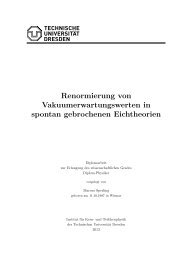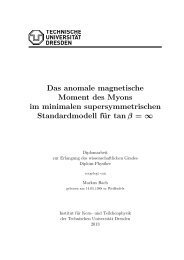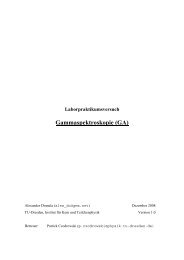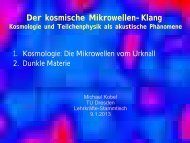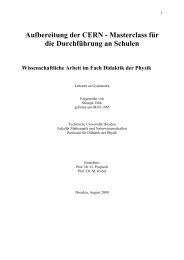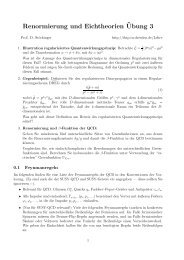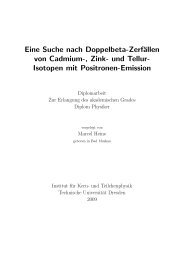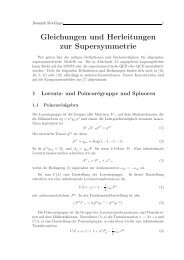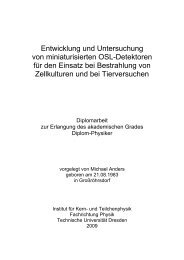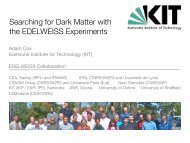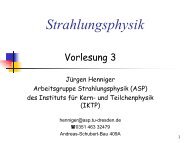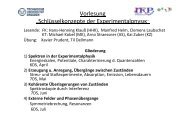A Mathematica based Version of the CKMfitter Package
A Mathematica based Version of the CKMfitter Package
A Mathematica based Version of the CKMfitter Package
You also want an ePaper? Increase the reach of your titles
YUMPU automatically turns print PDFs into web optimized ePapers that Google loves.
4 Chapter 2. Theory<br />
<strong>the</strong> bosons <strong>of</strong> <strong>the</strong> weak interaction, which have weak charge. The three fundamental<br />
interactions are summarized in Table 2.2.<br />
Interaction Couples to Vector Boson Mass (GeV/c 2 ) J P<br />
strong color 8 gluons 0 1 −<br />
electromagnetic electric charge photon γ 0 1 −<br />
weak weak charge W ± , Z 0 ≈ 10 2 1<br />
Table 2.2: The fundamental interactions<br />
The Standard Model is <strong>the</strong> combination <strong>of</strong> Quantum Chromodynamics and <strong>the</strong> unified<br />
<strong>the</strong>ory <strong>of</strong> electroweak interactions. It is a renormalizable quantum field <strong>the</strong>ory<br />
and carries <strong>the</strong> group structure <strong>of</strong> <strong>the</strong> gauge group SU(3)C ⊗SU(2)L ⊗U(1)Y , where<br />
C means color, L means left and Y is <strong>the</strong> electroweak hypercharge.<br />
The QCD, represented by <strong>the</strong> gauge group SU(3)C, is <strong>the</strong> <strong>the</strong>ory <strong>of</strong> strong interactions<br />
between colored quarks and gluons. Its coupling constant αS depends on <strong>the</strong><br />
energy scale µ, which leads at high energies to a weak coupling, called Asymptotic<br />
freedom, and a strong coupling at low energies leading to so-called Confinement.<br />
Due to <strong>the</strong> Confinement, no free quarks or gluons have been observed yet. They<br />
only occur in color-neutral bound states, called hadrons, which can be classified into<br />
baryons and mesons 3 .<br />
The unification <strong>of</strong> electro-magnetic and weak interaction is described in <strong>the</strong> model <strong>of</strong><br />
S. L. Glashow, S. Weinberg and A. Salam by <strong>the</strong> gauge group SU(2)L⊗U(1)Y ,<br />
where <strong>the</strong> fermions are represented by left-handed doublets and right-handed singlets<br />
<strong>of</strong> <strong>the</strong> weak isospin. Since gauge invariance requires <strong>the</strong> absence <strong>of</strong> explicit mass<br />
terms in <strong>the</strong> Lagrangian, all particles are initially assumed to be massless. As<br />
a possibility <strong>of</strong> mass generation without spoiling <strong>the</strong> gauge invariance, P. Higgs<br />
introduced a complex scalar doublet field Φ = (φ1, φ2), which leads to an additional<br />
term in <strong>the</strong> SM Lagrangian:<br />
LΦ = � ∂µΦ +� (∂ µ Φ) − V (Φ) (2.1)<br />
with a rotationally symmetric potential V (Φ) = −µ 2 Φ + Φ + λ 2 (Φ + Φ) 2 . The Yukawa<br />
interaction <strong>of</strong> <strong>the</strong> quarks with <strong>the</strong> Higgs field is described by:<br />
LY = −Y d<br />
ij ¯ Q I LiΦd I Rj − Y u<br />
ij ¯ Q I LiεΦ ∗ u I Rj + h.c. , (2.2)<br />
(q = u, d) are complex 3 × 3 matrices, i, j are <strong>the</strong> labels <strong>of</strong> <strong>the</strong> fermion<br />
are <strong>the</strong> left-handed<br />
represent <strong>the</strong> right-handed down- and up-type<br />
quark singlets in <strong>the</strong> basis <strong>of</strong> weak interaction eigenstates, denoted by I.<br />
where Y q<br />
ij<br />
generation and ε is <strong>the</strong> 2×2 total antisymmetric tensor. The QI Li<br />
quark doublets, where dI Rj and uI Rj<br />
3 Baryons are composed <strong>of</strong> three quarks with different color (qiqjqk), mesons are composed <strong>of</strong> a<br />
quark-antiquark pair (qi ¯q ī), where <strong>the</strong> indices i, j, k represent <strong>the</strong> color and ī <strong>the</strong> anti-color respectively.



